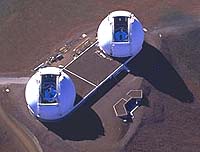
Posted on 07/02/2003 4:21:19 AM PDT by alnitak
Astronomers have observed a young star ringed by a swirling disc that may spin off planets, marking the first published science observation using two linked 10-meter (33- foot) telescopes in Hawaii.
The linked telescopes at the W.M. Keck Observatory on Mauna Kea, known as the Keck Interferometer, comprise the world's largest optical telescope system. The observation was made of DG Tau, a young star that has not yet begun to burn hydrogen in its core. Such stars are called T-Tauri objects. Observations of DG Tau were made on October 23, 2002, and February 13, 2003, and the findings will appear in an upcoming issue of the Astrophysical Journal Letters.
"We're trying to measure the size of the hot material in the dust disc around DG Tau, where planets may form," said Dr. Rachel Akeson, leader of the study team and an astronomer at the Michelson Science Center at the California Institute of Technology in Pasadena. "Studies like this teach us more about how stars form, either alone or in pairs, and how planets eventually form in discs around stars."
The Keck Interferometer observations revealed a gap of 18 million miles between DG Tau and its orbiting dust disc. Akeson notes that of the extra-solar planets - planets orbiting other stars - discovered so far, roughly one in four lies within 10 million miles of the parent star. Since planets are believed to form within a dust disc, either DG Tau's disc has a larger-than-usual gap, or the close-in planets form farther from the star and migrate inward.
Since 1995, astronomers have detected more than 100 extra- solar planets, many considered too large and close to their hot, parent stars to sustain life. By measuring the amount of dust around other stars, where planets may form, the Keck Interferometer will pave the way for NASA's Terrestrial Planet Finder mission. Terrestrial Planet Finder will look for smaller, Earth-like planets that may harbor life. The Keck Interferometer and Terrestrial Planet Finder are part of NASA's Origins Program, which seeks to answer the questions: Where did we come from? Are we alone?
"T-Tauri objects had been observed with other instruments, but only the brightest ones were detectable until now," Akeson said. "With the larger telescopes and greater sensitivity of the Keck Interferometer, we can look at fainter T-Tauri objects, like this one."
The Keck Interferometer gathers light waves with two telescopes and then combines the waves so they interact, or "interfere" with each other. It's like throwing a rock into a lake and watching the ripples, or waves, and then throwing in a second rock. The second set of waves either bumps against the first set and changes its pattern, or both sets join together to form larger, more powerful waves. With interferometry, the idea is to combine light waves from multiple telescopes to simulate a much larger, more powerful telescope.
In its ability to resolve fine details, the Keck Interferometer is equivalent to an 85-meter (279-foot) telescope. "The system transports the light gathered by the two telescopes to an optical laboratory located in the central building," said Dr. Mark Colavita of NASA's Jet Propulsion Laboratory (JPL), Pasadena, interferometer system architect and lead author of the paper. "In the lab, a beam combiner and infrared camera combine and process the collected light to make the science measurement."
To make these measurements, the interferometer's optical system adjusts the light paths to a fraction of a wavelength of light, and adaptive optics on the telescopes remove the distortion caused by Earth's atmosphere.
"This research represents the first scientific application of an interferometer with telescopes that use adaptive optics," said Dr. Peter Wizinowich, interferometer team lead for the W.M. Keck Observatory and co-author of the paper.
The development of the Keck Interferometer is managed by JPL for NASA's Office of Space Science, Washington. JPL is a division of the California Institute of Technology in Pasadena. The W.M. Keck Observatory is funded by Caltech, the University of California and NASA, and is managed by the California Association for Research in Astronomy, Kamuela, Hawaii.

There don't appear to be any pretty pictures of the star-disk system. There is a PDF of their paper via the link.
..Did he say..did he say..That was...33 FEET?
(Gorzaloon, suffering a 10"f5 Small Telescope Syndrome. Guess it's only a matter of time before I get some "Enlarge your telescope" spam..)
T Tauri stars are the young precursors of main sequence stars like the Sun.
NICMOS (Hubble) infrared image on the left; Hubble Wide-Field Planetary Camera 2 visible-light image on the right.



Hey, with some epoxy and a few mirrored tiles I'll bet you can upgrade that 10" 'scope to a 10-foot lightbucket in NO TIME! ;>D
(Gorzaloon, tiny, but <1/8 wave!)
(not a joke)
Primary mirror design Segment
Number of segments 36
Segment shape Hexagonal
Segment diameter 1.8 meters (6 feet)
Segment weight 880 pounds
Segment material Zerodur (low-expansion glass-ceramic)
Primary mirror diameter 10 meters (33 feet)
Light-collecting area 76 square meters (818 square feet)
Mirror curvature f/1.75 hyperbolic mirror
Focal length 17.5 meters (57.4 feet)
Total weight of glass 14.4 metric tons (15.9 tons)
Telescope mount Altitude-Azimuth
Overall telescope height 24.6 meters (80.7 feet)
Total moving weight with mirrors, 270 metric tons (298 tons)
It seems the link I posted is just a JPL Nasa site, this is the real Keck site:
and here is where I got those specs from: Specs
I am sure some of the ATM's here know how hard something like that is to make. The thought makes me feel like I am in an elevator with a broken cable. Even an f2 SPHERE can get tricky.
(In humble, cowed, intimidated whipped dog mode....)

Disclaimer: Opinions posted on Free Republic are those of the individual posters and do not necessarily represent the opinion of Free Republic or its management. All materials posted herein are protected by copyright law and the exemption for fair use of copyrighted works.